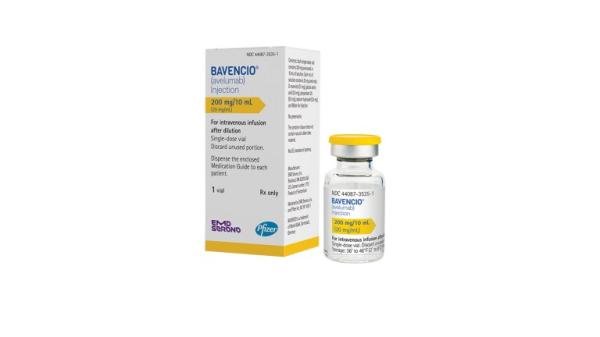Avelumab Side Effects
Applies to avelumab: intravenous solution.
Serious side effects of Avelumab
Along with its needed effects, avelumab may cause some unwanted effects. Although not all of these side effects may occur, if they do occur they may need medical attention.
Check with your doctor or nurse immediately if any of the following side effects occur while taking avelumab:
More common
- Back pain
- bloating or swelling of the face, arms, hands, lower legs, or feet
- chest tightness
- blurred vision
- chills
- clay-colored stools
- confusion
- constipation
- cough
- dark urine
- decreased appetite
- depressed mood
- dizziness, fainting, or lightheadedness when getting up suddenly from a lying or sitting position
- dry skin and hair
- feeling warm or cold
- fever
- hair loss
- headache
- hives or welts, itching, or skin rash
- hoarseness
- irritation
- joint pain, stiffness, or swelling
- muscle cramps and stiffness
- nausea
- nervousness
- pounding in the ears
- rapid weight gain
- redness of the face, neck, arms, and occasionally, upper chest
- redness, swelling, or pain of the skin
- scaling of the skin on the hands and feet
- slow or fast heartbeat
- stomach pain
- sweating
- swelling of the eyelids, face, lips, hands, or feet
- tingling of the hands or feet
- trouble breathing or swallowing
- ulceration of the skin
- unusual tiredness or weakness
- unusual weight gain or loss
- vomiting
- yellow eyes or skin
Less common
- Bloody urine
- chest pain
- decreased frequency or amount of urine
- general feeling of discomfort or illness
- increased thirst
- lower back or side pain
- pain in the chest, groin, or legs, especially the calves
- severe, sudden headache
- slurred speech
- sneezing
- sore throat
- stomach cramps
- sudden loss of coordination
- sudden, severe weakness or numbness in the arm or leg
- swelling of the face, fingers, lower legs
- thickening of bronchial secretions
- vision changes
- watery or bloody diarrhea
Rare
- Blistering, peeling, or loosening of the skin
- chest discomfort
- cloudy urine
- darkening of the skin
- difficulty in speaking
- double vision
- drowsiness
- dry mouth
- fruit-like breath odor
- inability to move the arms, legs, or facial muscles
- inability to speak
- increased hunger
- increased urination
- indigestion
- loss of appetite
- loss of consciousness
- muscle pain
- pains in the stomach, side, or abdomen, possibly radiating to the back
- red skin lesions, often with a purple center
- red, irritated eyes
- sensitivity to heat
- slow speech
- sores, ulcers, or white spots in the mouth or on the lips
- swollen glands
- trouble sleeping
- unexplained weight loss
- upper right abdominal or stomach pain
Other side effects of Avelumab
Some side effects of avelumab may occur that usually do not need medical attention. These side effects may go away during treatment as your body adjusts to the medicine. Also, your health care professional may be able to tell you about ways to prevent or reduce some of these side effects.
Check with your health care professional if any of the following side effects continue or are bothersome or if you have any questions about them:
More common
- Bone pain
- cracked lips
- decreased weight
- difficulty in moving
- voice changes
For Healthcare Professionals
Applies to avelumab: intravenous solution.
Cardiovascular
Very common (10% or more): Hypotension (25%), hypertension (13%)
Uncommon (0.1% to 1%): Myocarditis[Ref]
Dermatologic
Very common (10% or more): Urticaria (25%), rash (e.g., maculopapular, erythema, dermatitis bullous) (22%), pruritus (10%)
Uncommon (0.1% to 1%): Psoriasis, arthritis, exfoliative dermatitis, pemphigoid, Stevens Johnson syndrome (SJS)/toxic epidermal necrolysis (TEN), histiocytic necrotizing lymphadenitis, vasculitis, hypophysitis[Ref]
Endocrine
Common (1% to 10%): Immune-mediated thyroid disorders (hypothyroidism/hyperthyroidism)
Uncommon (0.1% to 1%): Adrenal insufficiency, hypopituitarism, hypophysitis[Ref]
Gastrointestinal
Very common (10% or more): Abdominal pain (25%), diarrhea (23%), nausea (22%), constipation (17%)
Common (1% to 10%): Immune-mediated colitis
Uncommon (0.1% to 1%): Pancreatitis[Ref]
Hematologic
Very common (10% or more): Lymphopenia (49%), anemia (35%), thrombocytopenia (27%)
Common (1% to 10%): Neutropenia
Rare (0.01% to 0.1%): Hemolytic anemia[Ref]
Hepatic
Very common (10% or more): Increased aspartate aminotransferase (AST) (34%), increased alanine aminotransferase (ALT) (20%)
Common (1% to 10%): Increased bilirubin
Uncommon (0.1% to 1%): Immune-mediated hepatitis[Ref]
Immunologic
Common (1% to 10%): Immunogenicity[Ref]
Local
Very common (10% or more): Anorexia (20%), weight loss (15%), increased lipase (14%)
Common (1% to 10%): Increased amylase[Ref]
Metabolic
Very common (10% or more): Anorexia (20%), weight loss (15%), increased lipase (14%)
Common (1% to 10%): Increased amylase[Ref]
Musculoskeletal
Very common (10% or more): Musculoskeletal pain (32%), back pain (25%), arthralgia (16%)
Common (1% to 10%):
Uncommon (0.1% to 1%): Myositis, rhabdomyolysis, myasthenia gravis[Ref]
Nervous system
Very common (10% or more): Dizziness (14%), headache (10%)
Uncommon (0.1% to 1%): Guillain-Barre syndrome, demyelination, encephalitis[Ref]
Respiratory
Very common (10% or more): Couth (18%), dyspnea (11%)
Common (1% to 10%): Immune-mediated pneumonitis, wheezing[Ref]
Renal
Rare (less than 0.1%): Immune-mediated nephritis[Ref]
Other
Very common (10% or more): Fatigue (50%), pyrexia (25%), chills (25%), flushing (25%), peripheral edema (20%)[Ref]
Ocular
Uncommon (0.1% to 1%): Uveitis, iritis[Ref]
Frequently asked questions
More about avelumab
- Check interactions
- Compare alternatives
- Reviews (1)
- Dosage information
- During pregnancy
- Drug class: anti-PD-1 and PD-L1 monoclonal antibodies (immune checkpoint inhibitors)
- Breastfeeding
- En español
Patient resources
Other brands
Professional resources
Other brands
Related treatment guides
References
1. Product Information. Bavencio (avelumab). EMD Serono Inc. 2017.
Further information
Always consult your healthcare provider to ensure the information displayed on this page applies to your personal circumstances.
Some side effects may not be reported. You may report them to the FDA.

